How to Create an Internal Wiki +Benefits, Tools, Tips (2024)
- Published:
- Updated: July 29, 2024


Today’s workforce spends a substantial chunk of its time on inefficient activities. A 2021 report found that 73% of employees spend 1-3 hours looking for information or trying to find specific documents at work.
In another recent workplace study, 60% of employees reported that it was difficult to obtain information from their colleagues needed to do their jobs. Enterprise organizations and growth companies must enable their employees with the performance support and documentation via self-service solutions to answer role-specific questions and find company-specific policies.
Internal wikis and knowledge bases are an effective way to maximize employee potential and retention and build a culture of knowledge sharing for your organization. Setting up an internal wiki can fix this massive time drain by centralizing information, so your employees spend less time scouring through old emails and documents.
What Is an Internal Wiki?
An internal wiki is a centralized database of knowledge that serves as a type of intranet for your organization. It’s an internal knowledge base that serves as a company’s encyclopedia that everyone can contribute to by creating and sharing information that helps employees get their jobs done, like policies, processes, or company news.
An internal wiki can serve as an ultimate knowledge management guide for your workplace — it can be the first stop for employees starting a project and a place where employees go to get unstuck when they’re struggling to complete a task. Internal wikis also shine as a forum for learning from experts inside your organization, creating a culture of knowledge sharing.
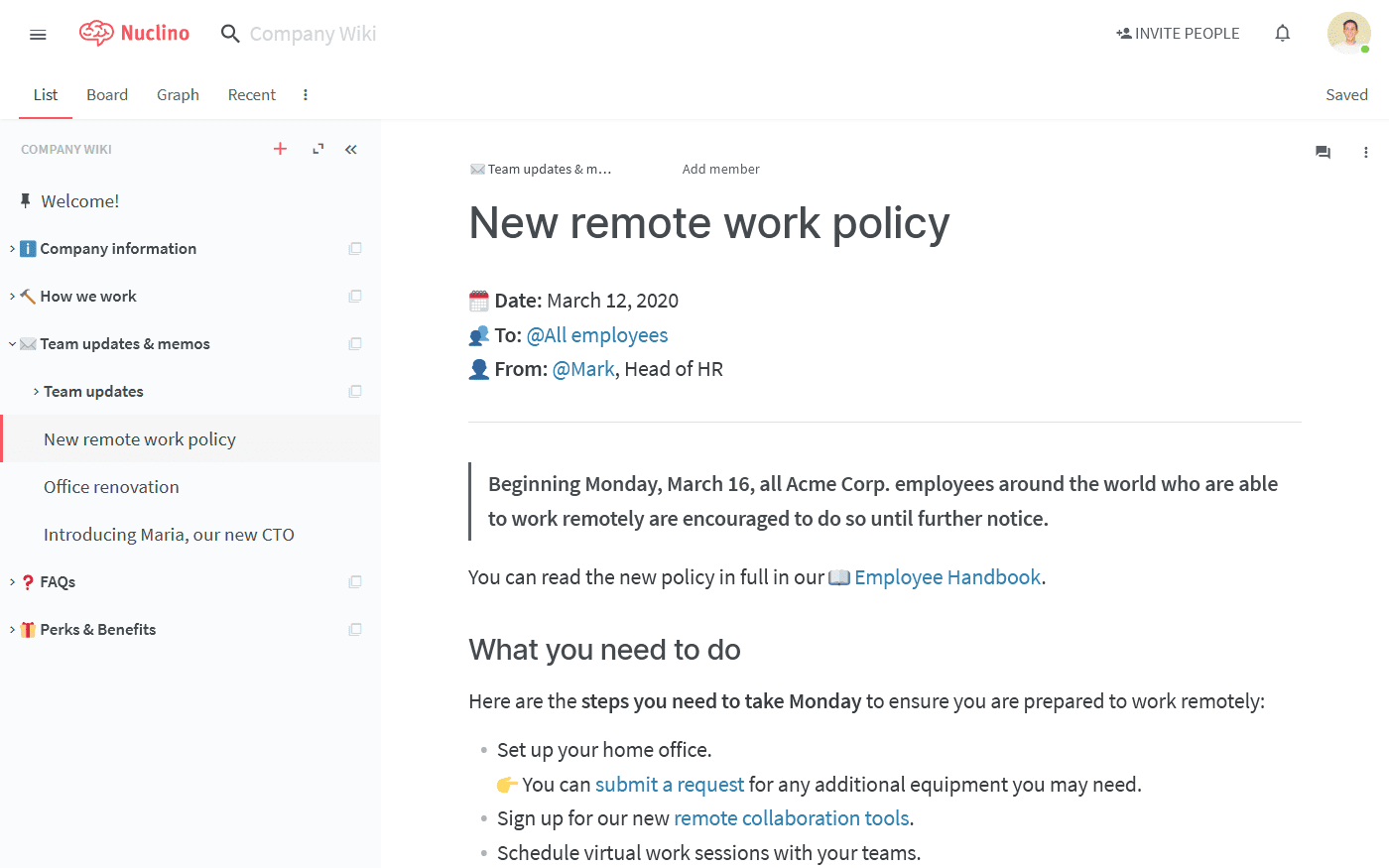
Above: Example of an internal wiki
Internal Wikis vs. Knowledge Bases
Internal wikis and knowledge bases have similar characteristics, but they aren’t the same thing. They’re both types of knowledge management software. Still, an internal wiki encourages collaboration by allowing contributions from multiple sources, while a knowledge base is usually curated and managed by a specific team.
Below you can see an example of Notion’s internal wiki:
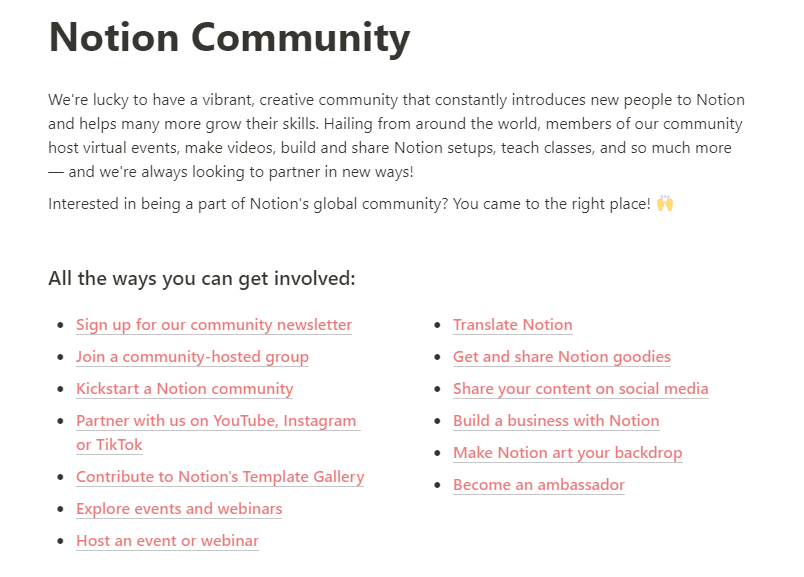
In addition, an internal wiki contains information about your company for internal use, while a knowledge base can be internal or externally-facing and is more likely to provide information about your products or services.
What Types of Content Do Internal Wikis Store?
Internal wikis can house any content related to your company, but it’s best to include information that will be useful to your employees as they move through their day-to-day duties.
Examples of what can be stored in an internal wiki include:
- Organizational information like vacation policies, company holidays, and job postings
- Company news and information
- Employee contact information
- Work procedures and checklists
- Training and onboarding processes, documents, and instructions
- Client and project information employees need when doing shared work
- Tutorials for using internal software
- Technical notes about current or past projects

Above: Enable your employees with contextual user support and accelerate IT adoption with Whatfix's digital adoption platform.
The Whatfix Digital Adoption Platform empowers IT teams to create in-app guidance and self-service user support on all internal desktop, web, and mobile applications. Enable employees with Self Help, which overlays onto your CRM, HCM, ERP, CPQ, and other digital workplace applications. Self Help connects to your process and IT documentation, LMS, video tutorials, onboarding documents, and other IT support-related content to provide employees self-help, at the moment of need. Create additional in-app guidance and pop-ups to contextually guide users through applications and alert them to process changes.
5 Benefits of Internal Wikis
Internal wikis are a popular knowledge management tool because they limit redundant questions and allow people on your team to access information faster. Wikis also promote productivity, creativity, and innovation by giving every employee access to everyone else’s brainpower.
Here are five benefits you can expect to see when implementing an internal wiki:
1. Facilitates collaboration from employees across your organization
One of an internal wiki’s top benefits is improving collaboration by improving your company’s knowledge access. They are particularly handy if you have remote works or a hybrid workplace, or people who work across departments on the same project since they promote information exchange, even for employees across oceans or time zones, in a public forum where the entire organization can see and benefit.
2. Simplified content authoring and centralized management of company knowledge
Internal wikis allow your company’s knowledge to be organized and presented in a user-friendly way. You can link documents together, which makes information much easier to manage and cuts down on the amount of duplicated information.
You can also include links to relevant content both inside and outside your wiki, so you don’t have to spend time duplicating information. For example, if an employee goes to your wiki to find out how to complete a task, those instructions can connect to related content for further understanding.
A huge benefit of using an internal knowledge base is storing commonly sought-after information like benefits, compensation, org structure, legal documents, and company branding. As a result, HR professionals won’t need to answer the same questions, and employees will feel satisfied knowing they don’t need to wait for a response to get the information they need.
Additionally, internal knowledge bases serve as a great place to publish company updates. New product launches, initiatives, or promotions are all great things to share companywide. Much internal knowledge base software includes features that will alert employees to company updates.
3. Increases performance and streamlines knowledge sharing
Not having an effective method of sharing information within an organization can lead to less productive teams. For example, in a Nintex study of America’s broken processes, 67% of employees surveyed said their company’s broken processes prevent them from maximizing their potential at work.
By centralizing necessary resources like how-to guides, best practice documents, and troubleshooting techniques, people will spend less time looking for answers and more time doing their job. The hassle of searching for information, 19% of employee’s workdays, is easily avoidable by providing needed resources in an internal knowledge base.
4. Increases your company’s speed of learning
Implementing an internal wiki will speed up the time it takes for your employees to learn, which will improve their overall workflow. It also makes the employee onboarding process much faster because new hires don’t have to wait for training — they can refer back to your wiki when they need help instead of looking for someone to help them. Making information easily accessible also reduces context switching, decreasing the time it takes to complete tasks or projects.
An internal wiki can even eliminate the need for some types of training, like how to use your company’s email system or the process for requesting time off. You can also distribute information faster because no one has to ask for administrative access or send information to your systems administrators and then wait for it to become widely available.
5. Achieves a greater degree of transparency
When all your internal documentation and information is available in one place that’s accessible companywide, it establishes a culture of transparency. Any move toward more transparency is positive for your company because it can profoundly affect employee engagement and make your employees feel valued.
6. Improves document security
Internal wikis provide added security because you can set them up to be accessible to only employees inside your organization. They’re also much more reliable than storing files on individual hard drives and stop you from losing information when an employee leaves your company without transferring their local files to you.
What to Include in Your Internal Knowledge Wiki
Your internal knowledge base should be unique to your company and employee needs. Remember, this information repository should prepare your team for everyday situations and questions they may encounter. While there is no one-size-fits-all list of what to include in your internal knowledge base, some commonly used resources are listed below:
- Information on employee benefits, 401K policies, time off, etc.
- Organizational structure and flow chart.
- Company vision statement and culture pillars.
- Who to reach out to for different support issues, like IT support.
- Process documents and instructional videos
- Continued learning opportunities.
- Company announcements.
- Branding and marketing guidelines
How to Create an Internal Wiki for Your Company
Rolling out an internal wiki is a significant project because you have to collect, create, and organize a large amount of knowledge and build it into a logical structure for your information. If not done correctly, your implementation will fall flat, so devising a step-by-step plan is essential.
Here are the basic steps for building an internal wiki:
1. Assemble a team to own your organization's wiki development and management
Your first step when creating an internal wiki is to gather your development team. Your team members will be dependent on the type of wiki you implement — if you’re self-hosting, you’ll need developers. If you subscribe to cloud-based wiki software, select at least one employee who will be using the wiki regularly to get your end-users perspective.
You’ll also need to assign at least one project manager to keep the building process moving forward. Your other team members will vary depending on your needs, but do your best to include as many stakeholders as possible.
2. Plan and implement an internal wiki or knowledge base software solution
Once you’ve chosen your internal wiki software, it’s time to start building. First, get your team together to create an implementation plan that includes timelines for when the new wiki software will be ready for adding content.
It’s important to understand your organization’s needs and requirements before selecting a solution – or face a failed software implementation that is both costly and time-consuming. Bring in key stakeholders from around the company to see what would be most helpful to them – as well as all integrations that will be needed with existing software apps – before shortlisting internal wiki vendors.
Internal knowledge base software helps streamline setup and future updates to your knowledge base. Additionally, the right internal knowledge base software provides tools that are customizable for your product or service. Our guide on the best knowledge base software to help inform your decision.
3. Assign owners for managing your company’s wiki content
While you’re in the building phase, figure out who will own and manage the content in your wiki. For example, your HR department is a good candidate for managing company policy documents, and your Learning and Development department should manage information related to training.
Make sure to ask your employees early if they have existing content or information to speed up the content development process and determine who will upload your initial content and act as a content moderator or editor.
While it may be tempting to compile all of your documents in one place and send them off, thinking strategically about your internal knowledge base will help avoid confusion and chaos. Consider the following to build a list of resources your employees need:
- Reoccurring employee concerns and questions
- Common missteps employees take
- Out-of-date practices that you’ve meant to update or rethink
4. Upload content to your company's wiki
Organize and categorize every piece of content that will go into your internal wiki. Once you have a logical structure in place, start uploading your content. As you start to place your content, take a look at the overall structure and make adjustments as needed. Be sure to consider tags and categories to help your wiki be easily searchable down the road.
5. Configure access rights and permissions
Determine who will be able to access the content in your internal wiki by setting your permissions and access rights. You can provide companywide access to your internal wiki, or you can restrict it to certain employees. Some wiki software will let you restrict access to certain documents or areas of your wiki, so decide now who needs access to what.
6. Onboard your employees
Internal wikis are generally easy to navigate, but your people might need training to author content. Before deploying, let your employees know you are creating an internal wiki and share it with everyone who will have access. In addition, you can use your internal wiki to store onboarding documents so employees can learn how to use your wiki by actually working with it.
7. Ask for feedback from employees
Internal wikis are generally easy to navigate, but your people might need training to author content. Before deploying, let your employees know you are creating an internal wiki and share it with everyone who will have access. In addition, you can use your internal wiki to store onboarding documents so employees can learn how to use your wiki by actually working with it.
How Do You Keep Your Wiki Content Relevant?
When you’re building the framework for your internal wiki, make sure to establish clear guidelines for what information employees are allowed to upload. Internal wikis can become useless and a burden to manage if they end up storing lots of random information that’s irrelevant, outdated, or not useful.
Before adding any content to your wiki, develop a process for evaluating the information your employees want to include and create guidelines for anyone who wants to share information. Once you’ve set up your guidelines, make sure to put them in a prominent place in your internal wiki, then point your employees to it before they can upload anything.
4 Best Internal Wiki Building Software
Here are four of the best software that allows your team to build internal wikis and similar style self-help and searchable content across your organization’s processes.

1. Whatfix
While not a full-fledged wiki-creation software, Whatfix builds upon the self-help features of internal wikis with its robust Digital Adoption Platform. Whatfix empowers HR departments and team leaders to create FAQ-style knowledge bases that live directly on your organization’s enterprise applications and company tools – with no coding or technical experience.
Its pseudo knowledge base can function as an internal wiki, allowing employees to become self-reliant with self-help resources right at the moment of need. HR departments can quickly maintain and update these flows and self-help widgets with new questions or application pain points as they arise. It also monitors usage rates of how employees are using an application and interacting with training materials, providing insights into improving training content as well as measuring your organization’s training effectiveness.
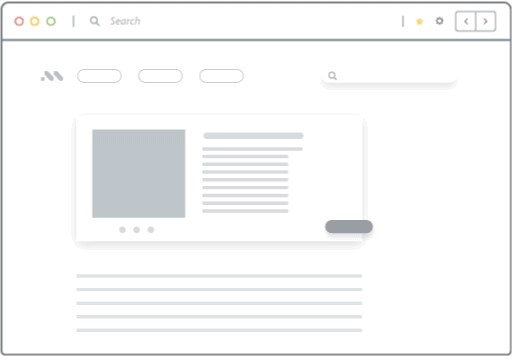

2. Notion
Notion is an all-in-one workspace that includes online tools meant for improving collaboration and knowledge sharing across organizations. It offers wiki templates you can modify to craft your workflow to suit your company’s needs.
In addition, Notion’s import feature lets you migrate your existing documents in a single batch and preserve the formatting in your documents when you upload them. Its simplistic interface that is reminiscent of note-taking apps such as Evernote and Apple Notes makes it an easy platform for employees to adopt and use.
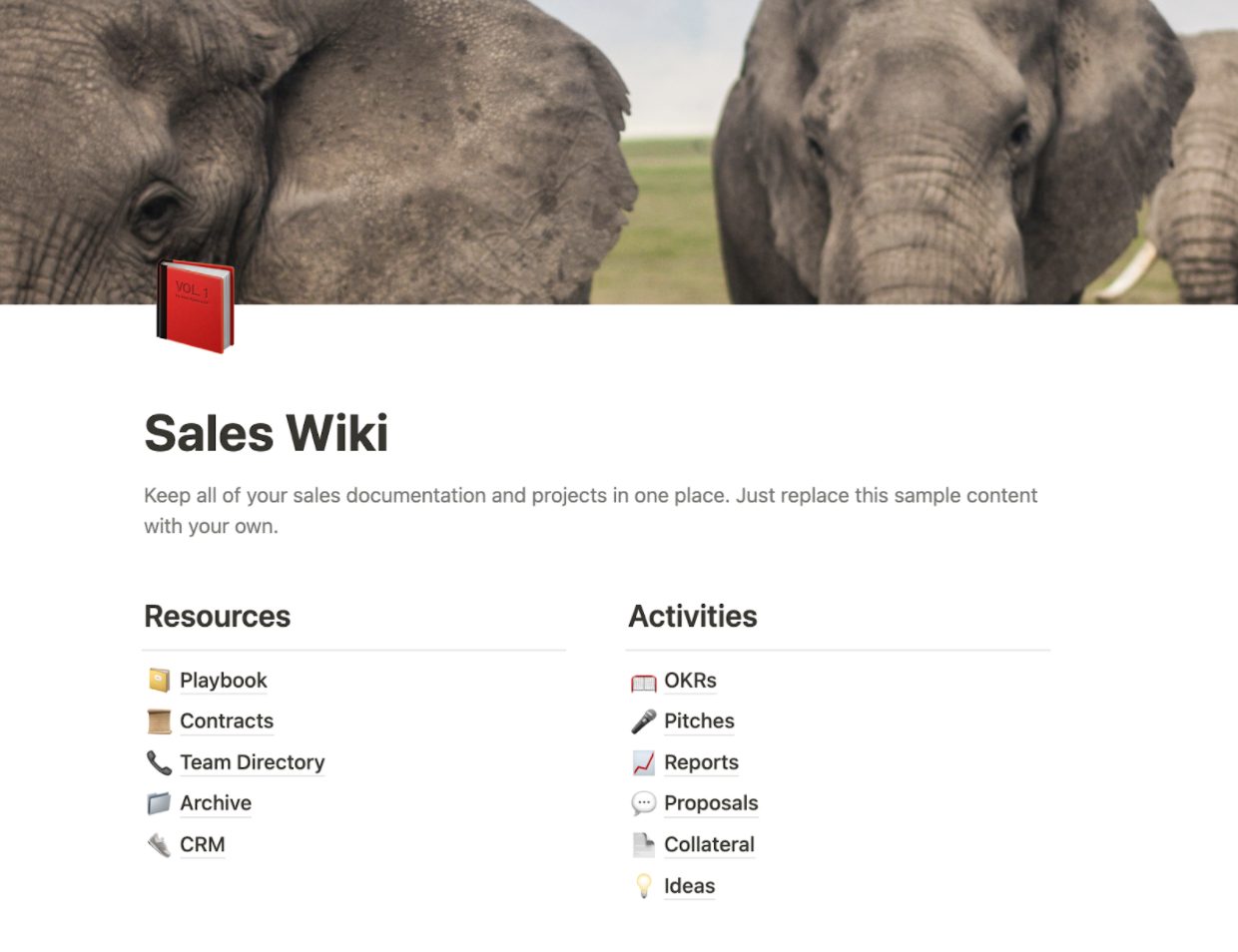

3. Guru
Guru is perhaps the most well-known internal knowledge base software on the market, with a wide range of features for building robust internal wikis. Its workflow and browser extension gives employees a fast way to access and contribute to a wiki. Guru is easy to create governance rules for and can be easily and quickly edited and maintained by owners across different business departments.
While it is narrow in terms of features mainly around wiki creation and management, it has hundreds of integrations to easily connect it with your company’s existing suite of learning, development, and training tools.


4. Document360
Document360 is a document creation, editing, and sharing platform with knowledge base features that provide a great solution for creating and managing an internal wiki. Its main appeal is a powerful set of collaboration features – including a robust content versioning system to see which version of a document is the most recent. This system helps ensure your organization’s wiki isn’t getting stale and makes certain your information is always up to date.
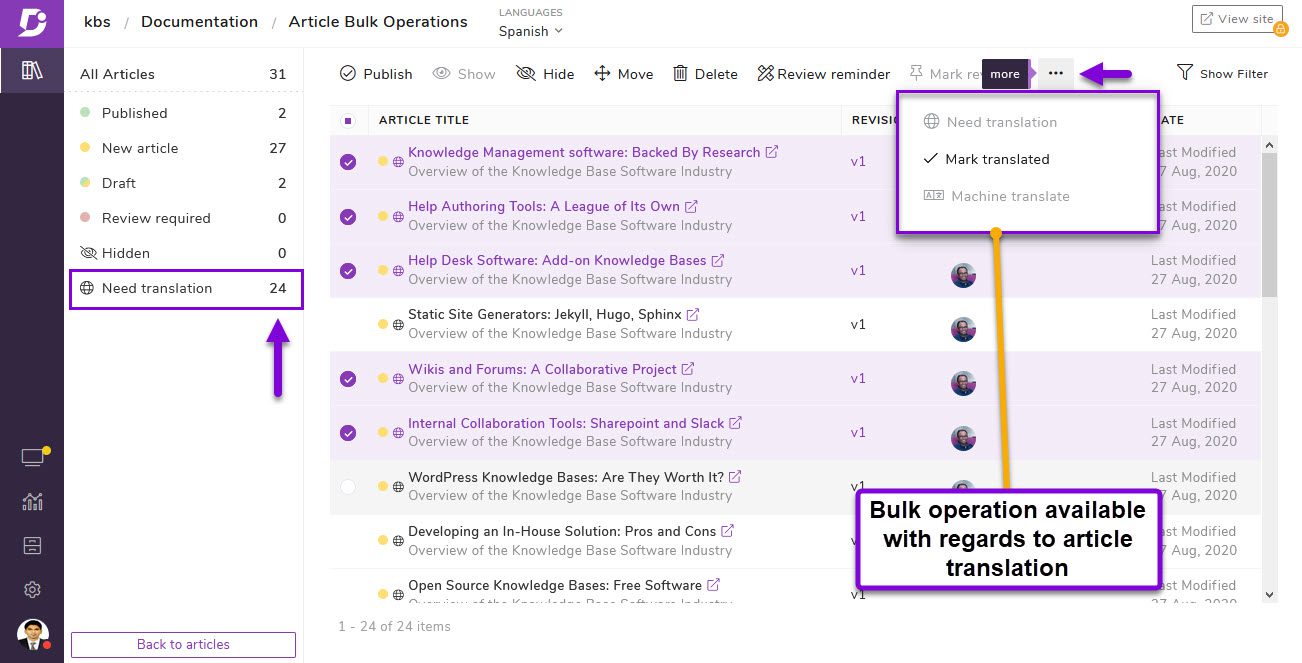
Every organization can benefit from centralizing its resources because it saves time, creates a better onboarding experience, and reduces turnover. Internal knowledge bases are a significant part of employee knowledge-sharing efforts, and it doesn’t have to stop there. Combine this repository of information with learning management tools and in-app guides for maximum effectiveness.
With Whatfix, create interactive workflows, self-help FAQs, nudges, task lists, and more – all directly embedded in your enterprise apps. Drive user adoption and proficiency across your enterprise apps with Whatfix today!
Request a demo to see how Whatfix empowers organizations to improve end-user adoption and provide on-demand customer support
Thank you for subscribing!


